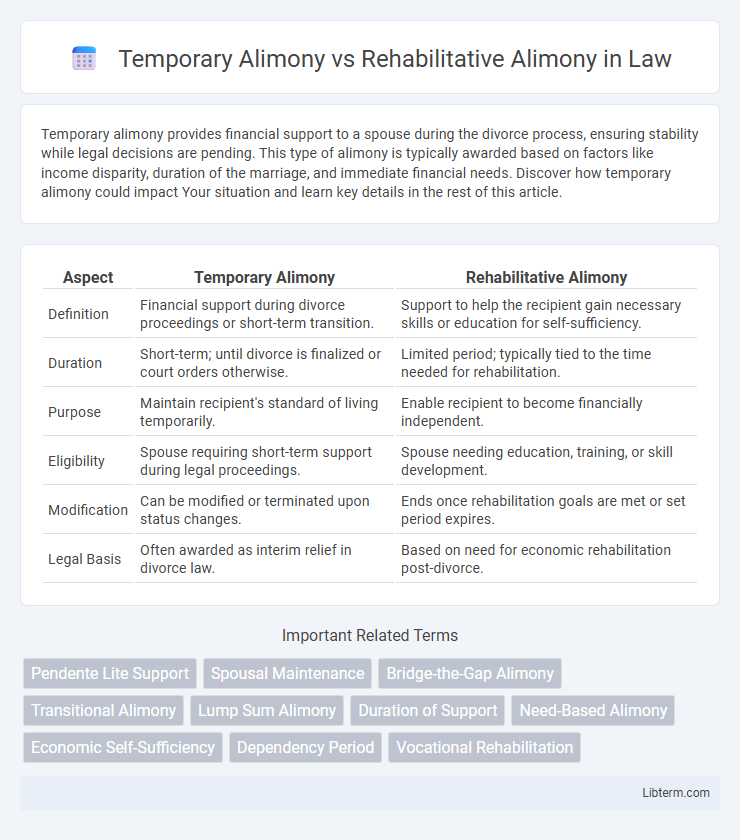Temporary alimony provides financial support to a spouse during the divorce process, ensuring stability while legal decisions are pending. This type of alimony is typically awarded based on factors like income disparity, duration of the marriage, and immediate financial needs. Discover how temporary alimony could impact Your situation and learn key details in the rest of this article.
Table of Comparison
| Aspect | Temporary Alimony | Rehabilitative Alimony |
|---|---|---|
| Definition | Financial support during divorce proceedings or short-term transition. | Support to help the recipient gain necessary skills or education for self-sufficiency. |
| Duration | Short-term; until divorce is finalized or court orders otherwise. | Limited period; typically tied to the time needed for rehabilitation. |
| Purpose | Maintain recipient's standard of living temporarily. | Enable recipient to become financially independent. |
| Eligibility | Spouse requiring short-term support during legal proceedings. | Spouse needing education, training, or skill development. |
| Modification | Can be modified or terminated upon status changes. | Ends once rehabilitation goals are met or set period expires. |
| Legal Basis | Often awarded as interim relief in divorce law. | Based on need for economic rehabilitation post-divorce. |
Introduction to Temporary and Rehabilitative Alimony
Temporary alimony provides financial support to a spouse during the divorce process, ensuring stability until a final settlement is reached. Rehabilitative alimony assists a spouse in becoming self-sufficient by funding education or job training after divorce. Both types of alimony address different phases of financial need and recovery in divorce proceedings.
Defining Temporary Alimony
Temporary alimony is a court-ordered financial support provided to a spouse during the divorce process to maintain their standard of living until the final settlement. It differs from rehabilitative alimony, which aims to support a spouse in gaining education or job skills to become self-sufficient post-divorce. Courts typically consider factors such as income disparity, duration of marriage, and each party's financial needs when determining temporary alimony.
Understanding Rehabilitative Alimony
Rehabilitative alimony is designed to provide financial support for a specific period while the recipient acquires education, training, or skills needed to become self-sufficient. Unlike temporary alimony, which offers short-term support during divorce proceedings, rehabilitative alimony emphasizes long-term independence by funding career development or job retraining. Courts typically set clear objectives and timelines to ensure the recipient achieves financial stability and no longer requires spousal support.
Key Differences Between Temporary and Rehabilitative Alimony
Temporary alimony provides short-term financial support during the divorce process to maintain one spouse's standard of living until a court issues a final alimony order, while rehabilitative alimony is designed to support a spouse's transition to self-sufficiency by funding education or job training. Temporary alimony usually ends once the divorce is finalized or a new support agreement is established, whereas rehabilitative alimony has a fixed duration tied to specific rehabilitation goals. Courts typically consider factors such as the length of the marriage, each spouse's earning capacity, and the purpose of the support when determining eligibility and amounts for both types of alimony.
Legal Criteria for Awarding Temporary Alimony
Temporary alimony is granted based on immediate financial need during the divorce process, considering factors such as the paying spouse's ability to pay and the recipient spouse's lack of income or earning capacity. Courts evaluate the duration of the marriage, standard of living, and the recipient's need for support while seeking employment or further education. Unlike rehabilitative alimony, which supports education or training for self-sufficiency, temporary alimony is focused on maintaining financial stability until a final divorce settlement is reached.
Eligibility Requirements for Rehabilitative Alimony
Rehabilitative alimony requires the recipient to demonstrate a clear and reasonable plan for gaining financial independence through education, training, or work experience. Eligibility typically depends on factors such as the spouse's current financial status, the duration of the marriage, and the potential for self-sufficiency within a defined period. Unlike temporary alimony, which supports immediate needs during divorce proceedings, rehabilitative alimony is contingent upon the recipient's commitment to improving their employment prospects.
Duration and Termination of Temporary Alimony
Temporary alimony is awarded for a limited period during the divorce process, often ending once the divorce is finalized or a permanent support order is issued. Its duration is specifically tied to maintaining the dependent spouse's financial stability while the court resolves the final settlement. Termination occurs automatically upon divorce decree entry or when the court modifies or replaces the temporary support arrangement with rehabilitative or permanent alimony.
Duration and Termination of Rehabilitative Alimony
Temporary alimony provides financial support during the divorce process and typically ends when the divorce is finalized or a specified event occurs. Rehabilitative alimony is designed to assist the recipient spouse in gaining self-sufficiency, lasting only as long as necessary to complete education, training, or employment adjustments. Termination of rehabilitative alimony usually occurs upon achieving agreed-upon goals, expiration of the set time period, or significant changes in financial circumstances.
Factors Courts Consider in Alimony Decisions
Courts consider factors such as the duration of the marriage, each spouse's financial resources, earning capacity, and contributions to the marriage when deciding between temporary and rehabilitative alimony. Temporary alimony is often granted to provide financial support during the divorce process or a transitional period, while rehabilitative alimony aims to assist a spouse in gaining financial independence through education or job training. The court also evaluates the recipient's needs and the payer's ability to pay to ensure equitable support tailored to both parties' circumstances.
Choosing the Right Alimony Type for Your Divorce
Choosing the right alimony type for your divorce depends on your financial needs and the length of the marriage. Temporary alimony provides short-term support during the divorce process, ensuring stability until a permanent arrangement is decided. Rehabilitative alimony focuses on helping the recipient become self-sufficient by funding education or job training for a limited period.
Temporary Alimony Infographic

 libterm.com
libterm.com